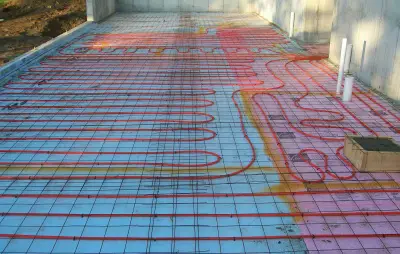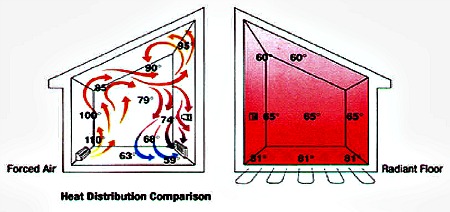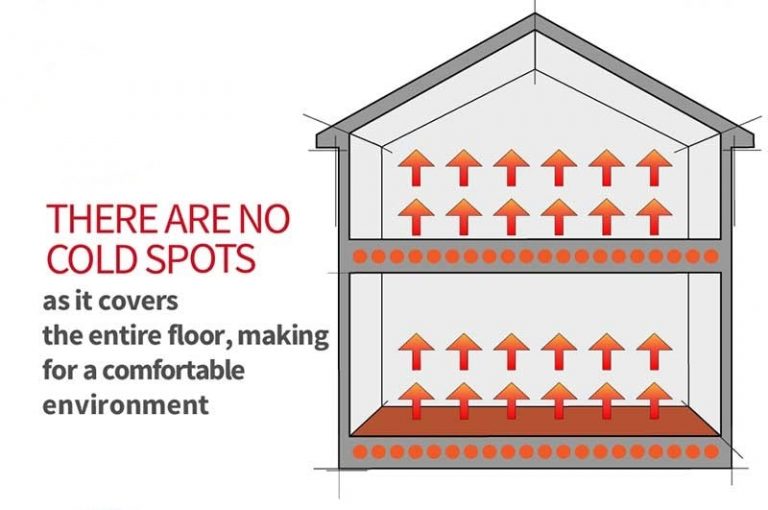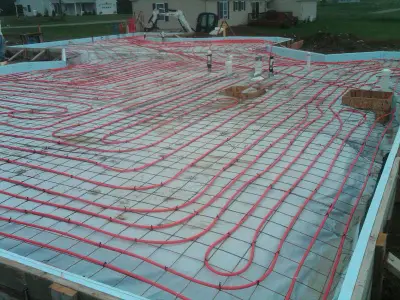Learn the truth about concrete floor heating
Being in the concrete business in Maine, I see a lot of people installing concrete floor heating as their main source of heat. I've poured hundreds of concrete floors with radiant heat and have learned a lot about how it works including the:
- Advantages Over Other Heating Systems
- What Are Some Disadvantages
I created this page to tell you my opinion on radiant floor heating and if I think it is worth it.
WHAT IS RADIANT FLOOR HEATING?
Quite simply, concrete floor radiant heat is a system of pex-tubes that carry hot water throughout a concrete floor or slab.
Or... radiant heat can be an electrical heating element embedded into a very thin concrete overlay, then tiled, carpeted, or have wood flooring installed over it.
When the thermal mass of the concrete is heated, the warm slab acts as a radiator distributing even heat throughout the structure.

The picture above shows a concrete floor we're about to pour with radiant heating tubes installed.
The concrete was 4" thick and the insulation under the slab was 2" thick.
The heating contractor laid out the pex tubing according to the "zones" that were established for heating the home.
The pex tubes were attached to wire mesh using zip ties. The wire mesh, when installed properly, allows for nice, even rows that can either be 6" apart or 1' apart.
How does radiant heat work?
There's two basic types of concrete floor heating, hydronic and electric.
The most cost effective system for medium to larger homes is hydronic since the amount of power it would take to heat a whole home with electric would be substantial.
Due to it's density and low conductivity, concrete retains heat very well. When the concrete floor is heated the heat rises, warming everything in the room.

Warm heat distributed with forced-hot-air systems is uneven. Most of the heat rises to the ceiling.
With radiant floor heating in concrete, the heat is concentrated at the floor making you feel comfortable at a lower thermostat setting and will eventually rise to heat your entire house.

is radiant floor heating expensive?
There are 2 different costs when it comes to radiant floor heating:
- the price to run
- the price to install
The cost to run:
Both types of radiant floor heating tend to cost around $1 - $5 for 24 hours.
The cost to install:
To install the Hydronic System- The price can range between $6 - $20 per square foot. The average price however is usually $13 per square foot.
To install the Electric System- The price can range between $8 - $15 per square foot. The average price is right around $11 per square foot.
Radiant floor heating can be as expensive or as cheap as you want it to be.
To get it professionally installed at the "higher end" of the spectrum, it can cost you thousands of dollars, especially if you are getting it installed for your entire house.
If you are looking to save some money, you can try to install it yourself, so you don't have to pay for someone's time and labor, only materials.
what are the Benefits of concrete floor radiant heat?
- Lower energy costs - can operate a hydronic system at a lower thermostat setting saving energy.
- Lower heating costs - heat is concentrated in lower half of room resulting in less heat loss.
- Comfortable - draft free and evenly distributed heat throughout your home.
- Healthy - no air is being blown into a room which could circulate pollutants.
- Silent - the system is completely concealed in the concrete with no air vents, baseboards or wall radiators.
What are Some disadvantages of concrete floor radiant heat?
- Up-front costs - installation costs usually run higher compared to traditional heating systems.
- Quick heat - it takes longer to initially heat up a room because you have to heat all that concrete first.
- Floor coverings - some flooring materials like carpet can slow the rate it takes to heat a room.
how long does radiant floor heating last?
Radiant floor heating usually lasts around 20-35 years
As you can see, we pour many concrete floors with radiant heat installed, especially since we live in Maine and deal with very cold winters. I'd say we pour at least 1 concrete floor with radiant heat, weekly.
is radiant floor heating worth it?
I've been on a lot of job-sites and poured a lot of concrete floors where radiant heat is being installed.
Personally, I would hire a professional to do the installation of the pex tubing instead of trying to do it myself.
- What I notice is the pex tubes need to be a certain distance apart depending on the design.
- The tubes need to be fastened securely so the concrete floor guy doesn't disturb them.
- Knowing how to lay-out each zone so the tubes don't cross over each other is important.
- Having the right tools to install the tubes makes the process very efficient.
- Properly locating the manifold - impossible to change once the concrete is poured.
- Checking for leaks and knowing what to do if you have one.
These are all things I feel are best left to someone who is trained to install radiant heat in concrete floors.
Once the concrete is poured there's no going back and trying to change something if it's not working properly.

Here's a concrete slab we're getting ready to pour with the radiant heat installed professionally.
Notice the styrofoam going up the edge of the slab to reduce heat loss. This is one step I see left out of a lot of radiant installations.
I do think concrete floor heat is a great way to go. If I were building a new home I would install it in all my concrete floors.
Where can I buy pex tubing for my radiant heat floors?
If you're thinking of installing you're own radiant heat floors, you can buy your pex tubing right from Amazon.com.
This pex tubing is for good for light commercial and residential applications.
Some other tools and supplies you may need:
- Pex tubing cutter
- Cinch clamp tool
- 1/2" pex cinch clamp ring
- 1/2" elbow fitting 90 degree
- J-Hook clamp
- Zip ties
Can I install radiant floor heat in my existing home?
The simple answer to that is YES, especially if you're re-modeling and installing new tile, carpet or wood flooring.
But there are some things you have to take into consideration.
There is and electric radiant floor heat system that can be embedded in a mortar mix or a self-leveling concrete overlay.
Then you can install tile, carpet, or wood flooring over this to have heated floors.
Floor height may be an issue for older exiting homes. You would have to remove the existing flooring and allow for this new floor.
The thickness of the new floor would be the total of the concrete overlay and the type of flooring you choose. This could be approximately 1 inch more or less.














